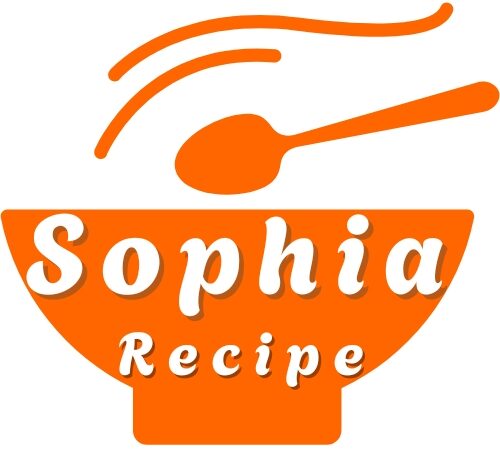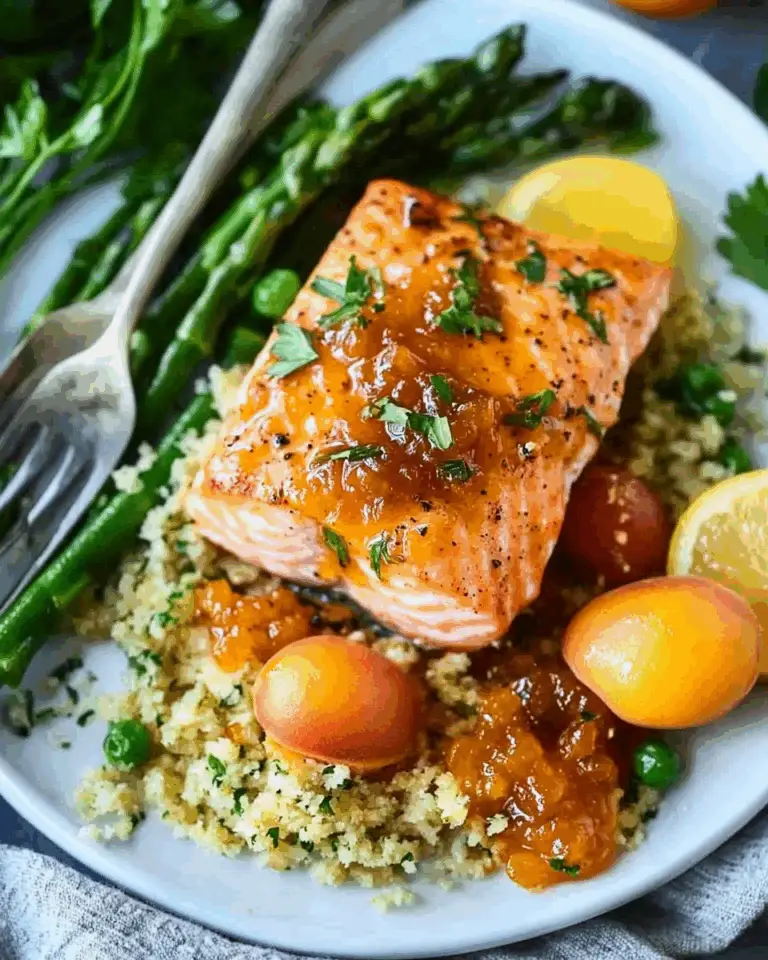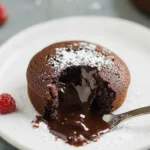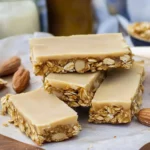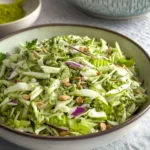This Apricot Dijon Glazed Salmon is a flavorful, easy-to-make dinner that balances sweet and tangy apricot preserves with the sharpness of Dijon mustard. The glaze caramelizes beautifully on the salmon, creating a deliciously sticky coating that pairs perfectly with the tender, flaky fish. Ready in under 30 minutes, it’s ideal for busy weeknights or a simple yet elegant meal.
Full Recipe:
Ingredients
-
4 salmon fillets (about 6 oz each)
-
¼ cup apricot preserves
-
2 tablespoons Dijon mustard
-
1 tablespoon soy sauce
-
1 tablespoon olive oil
-
1 clove garlic, minced
-
Salt and pepper, to taste
-
Optional garnish: chopped parsley or green onions
Directions
-
Preheat oven to 400°F (200°C). Line a baking sheet with parchment paper or foil.
-
In a small bowl, whisk together apricot preserves, Dijon mustard, soy sauce, olive oil, and minced garlic until smooth.
-
Place salmon fillets on the prepared baking sheet and season with salt and pepper.
-
Brush the apricot-Dijon glaze generously over the salmon fillets.
-
Bake for 12-15 minutes, or until the salmon is cooked through and flakes easily with a fork. For extra caramelization, broil for an additional 1-2 minutes, watching carefully to avoid burning.
-
Remove from oven and garnish with chopped parsley or green onions if desired. Serve immediately.
Nutrients
-
Calories: approx. 300 kcal per serving
-
Protein: 34 g
-
Fat: 18 g
-
Carbohydrates: 8 g
-
Fiber: 0 g
-
Sugar: 7 g
-
Sodium: 450 mg
The Appeal of Salmon as a Main Ingredient
Salmon is prized worldwide for its rich flavor, vibrant color, and impressive health benefits. Its naturally high fat content, particularly omega-3 fatty acids, contributes to its moist, buttery texture and heart-healthy properties. The fish’s mild yet distinctive taste pairs well with a variety of sauces and seasonings, making it incredibly versatile in the kitchen.
In this recipe, the salmon’s tender, flaky flesh provides a perfect canvas for the apricot Dijon glaze. Baking salmon ensures that it retains moisture and delicate texture without becoming dry. The relatively short cooking time allows the fish to cook through while maintaining a juicy interior, making it accessible for cooks of all skill levels.
Flavor Profile of the Apricot Dijon Glaze
The glaze is the defining feature of this dish. Apricot preserves bring a natural sweetness and slight tartness, which balances beautifully with the sharp, tangy intensity of Dijon mustard. The mustard adds complexity with its subtle heat and depth, preventing the glaze from becoming overly sweet or one-dimensional.
Soy sauce introduces an umami richness and slight saltiness that deepens the overall flavor, while olive oil adds a smooth mouthfeel and helps the glaze adhere to the salmon. Garlic adds aromatic warmth and savory undertones, rounding out the flavor profile.
When baked, the glaze caramelizes, forming a sticky, glossy coating that adds a pleasing textural contrast to the soft salmon. This interplay of sweet, tangy, and savory elements makes the dish flavorful and exciting without overwhelming the palate.
Health Benefits of Apricot Dijon Glazed Salmon
This dish offers a nutritious balance of macronutrients. Salmon is an excellent source of high-quality protein, essential for muscle repair and overall health. It’s also rich in omega-3 fatty acids, which support cardiovascular health, brain function, and inflammation reduction.
The glaze contains natural sugars from the apricot preserves but remains moderate in carbohydrates and sugars overall. Soy sauce contributes sodium, so seasoning should be monitored if sodium intake is a concern. The use of olive oil adds heart-healthy monounsaturated fats, contributing beneficial fats without excess saturated fat.
Overall, this salmon dish fits well within balanced diets aimed at supporting health while satisfying flavor cravings.
Cooking Technique and Tips for Success
Baking is a straightforward and healthy cooking method for salmon. The key to success lies in ensuring the fish cooks evenly without drying out. Using a baking sheet lined with parchment paper or foil helps with easy cleanup and prevents sticking.
Applying the glaze generously before baking allows it to infuse the fish with flavor as it cooks. Broiling for a brief final step adds extra caramelization and texture but requires close attention to avoid burning the glaze.
Salmon fillets should be of uniform thickness to ensure even cooking. Allowing the salmon to rest briefly after baking helps redistribute juices and maintains moistness. Seasoning with salt and pepper before applying the glaze enhances the fish’s natural flavor.
Serving Suggestions and Pairings
Apricot Dijon Glazed Salmon pairs beautifully with a variety of sides, complementing its bright and savory flavors. Roasted or steamed vegetables such as asparagus, green beans, or broccoli provide a fresh and nutrient-rich accompaniment. Light grain options like quinoa, couscous, or wild rice absorb the glaze’s extra sauce and round out the meal.
For a crisp contrast, consider serving the salmon with a fresh salad dressed in a light vinaigrette. The acidity and crunch of the salad balance the rich glaze and tender fish.
Garnishing with chopped parsley or green onions adds color, freshness, and a subtle herbal note, enhancing both flavor and presentation.
Versatility and Adaptations
This glaze is versatile and can be adapted to suit different palates or dietary needs. For example, substituting tamari for soy sauce makes the dish gluten-free. Adjusting the sweetness by varying the amount of apricot preserves or adding a splash of lemon juice can tailor the glaze’s flavor.
For those who prefer more heat, a pinch of chili flakes or a dash of hot sauce incorporated into the glaze can add a spicy kick. Fresh herbs such as thyme or dill can be added as garnish or into the glaze for extra aromatic layers.
This flexibility allows the recipe to be customized easily, making it a favorite for families with varied tastes or those who enjoy experimenting with flavors.
Cultural and Culinary Context
Combining fruit preserves with savory proteins is a technique seen in many cuisines, bringing together sweet and savory in harmonious ways. Apricot and mustard are classic partners, with the sweetness of apricot balancing the sharpness of mustard, a flavor profile embraced in European and Mediterranean cooking.
Salmon’s popularity globally, especially in healthy and contemporary cuisines, makes this recipe appealing to a wide audience. It reflects modern trends that favor fresh, minimally processed ingredients paired with bold yet balanced flavors.
Conclusion
Apricot Dijon Glazed Salmon is a delightful dish that combines tender, flaky salmon with a sticky, flavorful glaze bursting with sweet and tangy notes. Its simplicity in preparation, coupled with a sophisticated flavor profile, makes it ideal for quick weeknight meals or special dinners.
The glaze’s harmonious blend of apricot preserves, Dijon mustard, soy sauce, olive oil, and garlic creates a complex and inviting taste that complements the rich salmon without overpowering it. Baking the salmon with this glaze results in a caramelized exterior and juicy interior that is sure to impress.
Healthy, flavorful, and versatile, this salmon dish can be paired with numerous sides to suit any meal occasion. Its ability to adapt to different tastes and dietary needs, combined with its ease of preparation, makes it a staple recipe that belongs in every home cook’s repertoire.
Whether serving family, entertaining guests, or enjoying a quiet night in, Apricot Dijon Glazed Salmon offers a satisfying, elegant, and nourishing option that celebrates the simple pleasures of great ingredients prepared with care.
